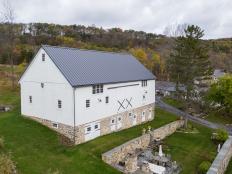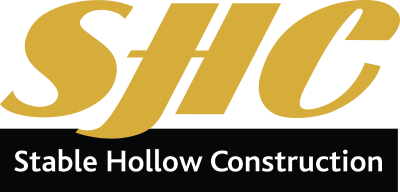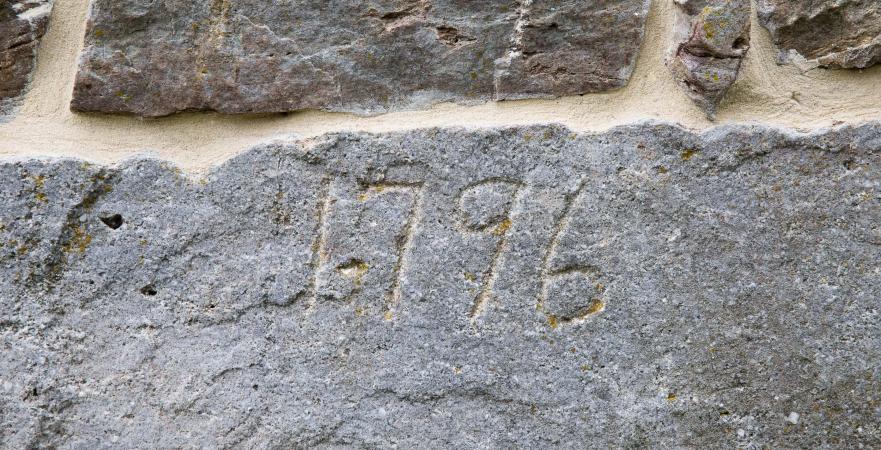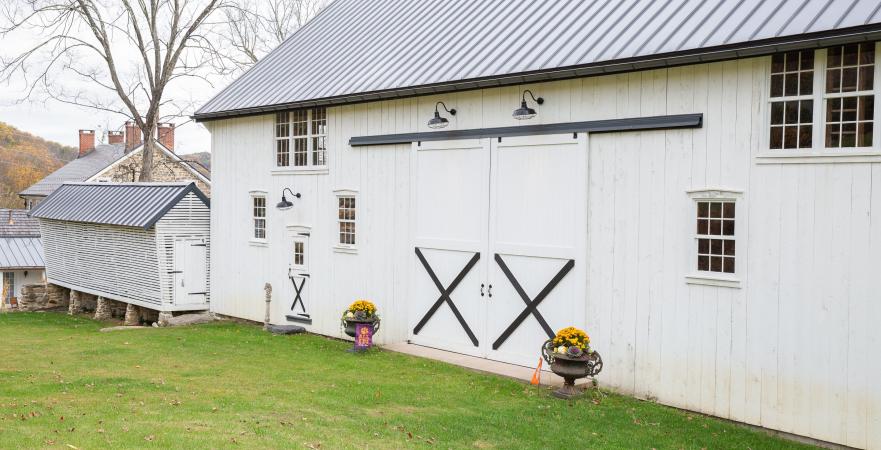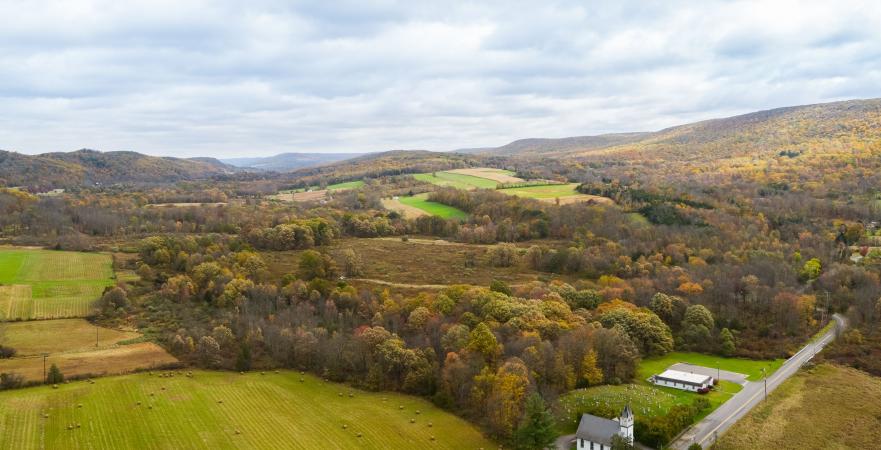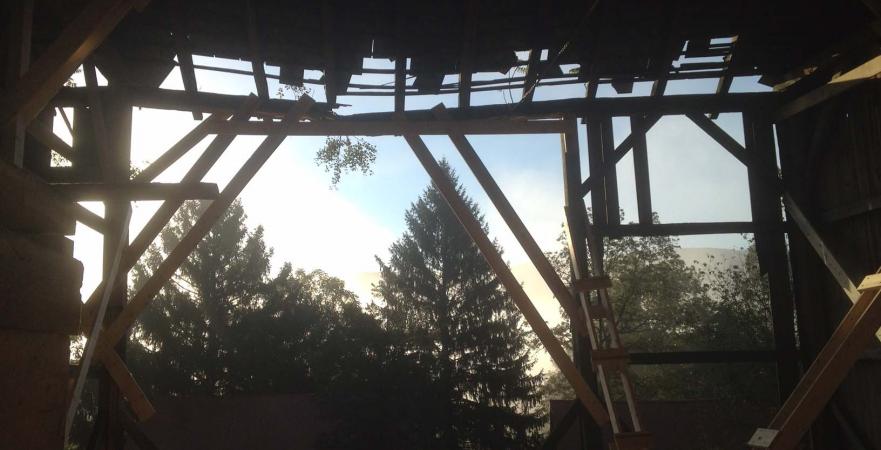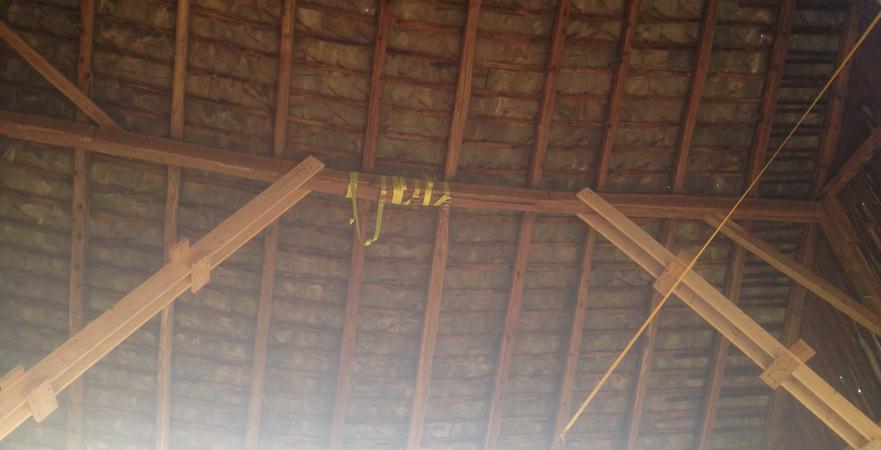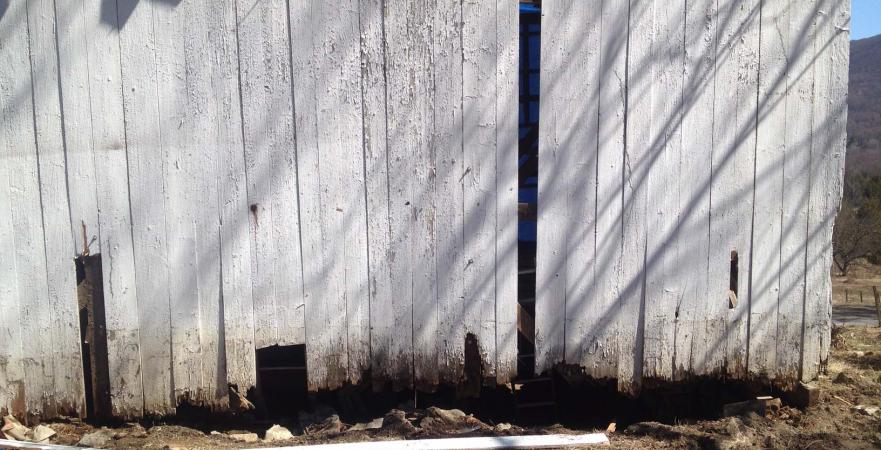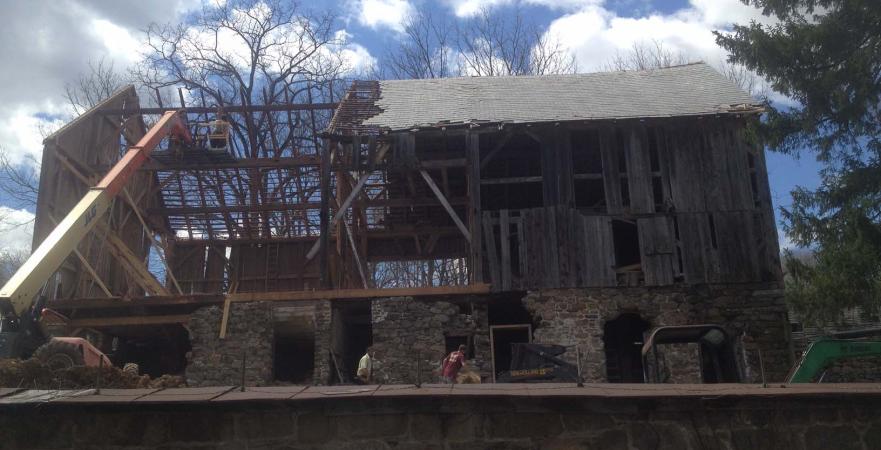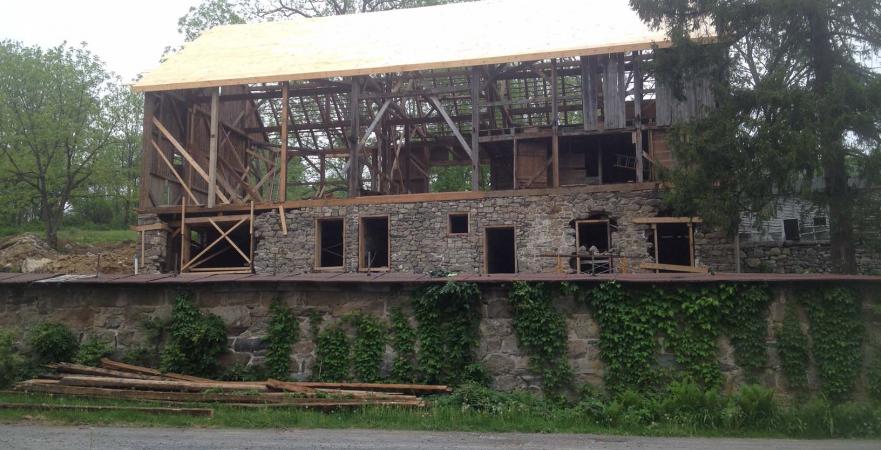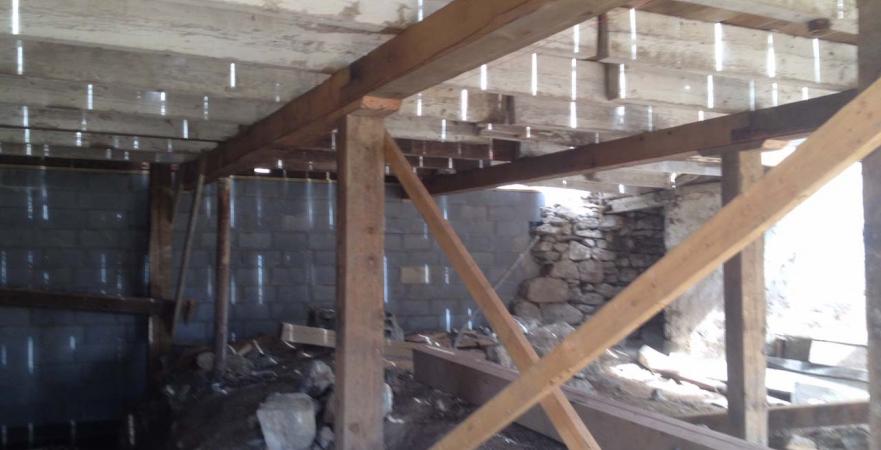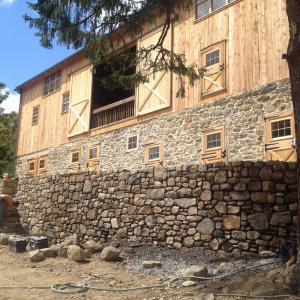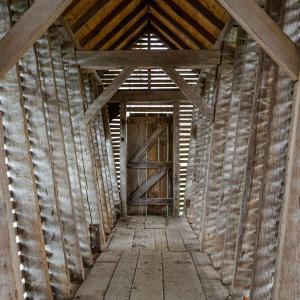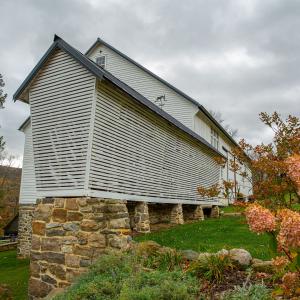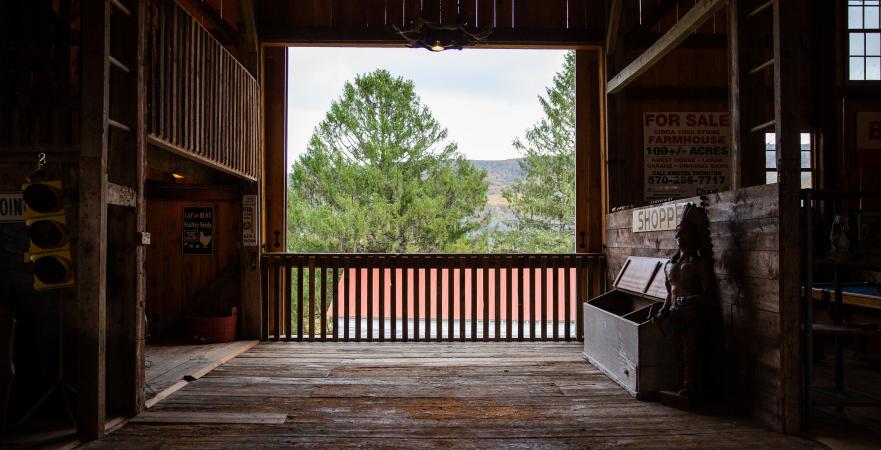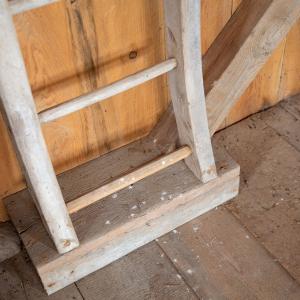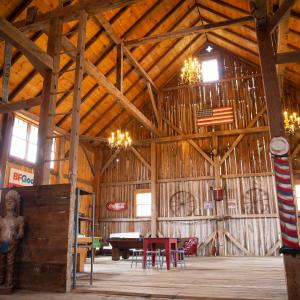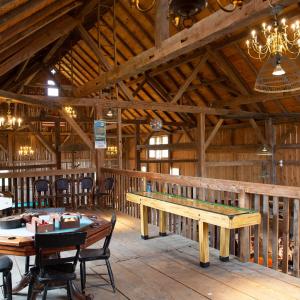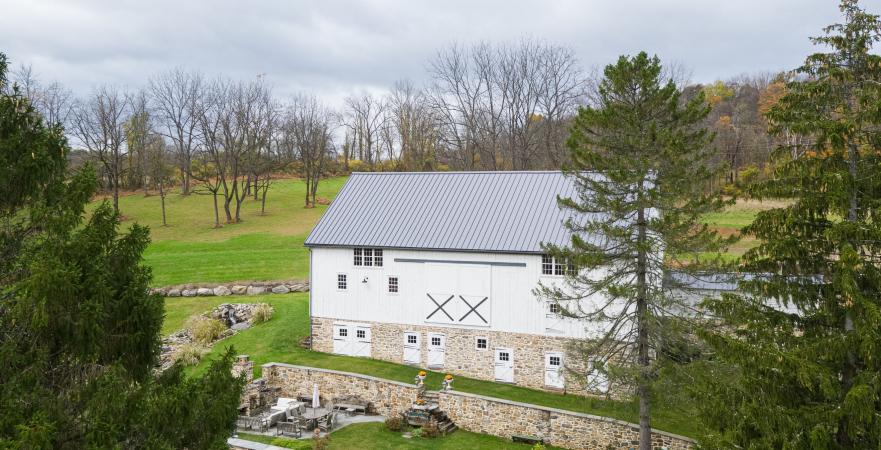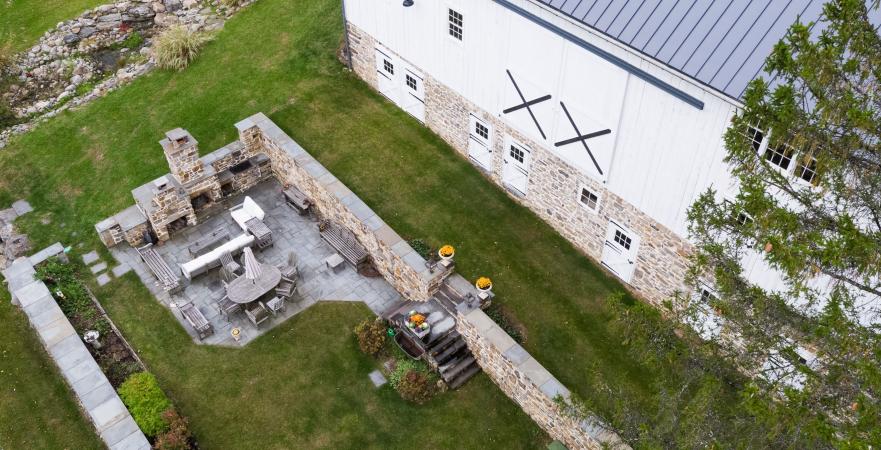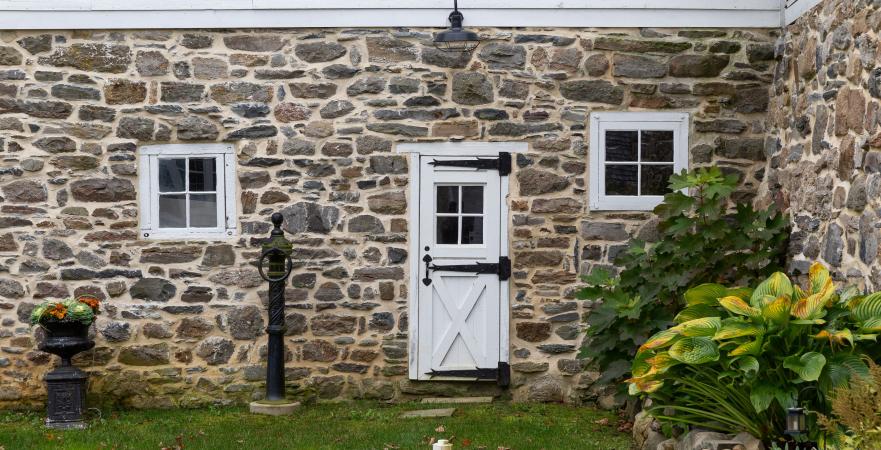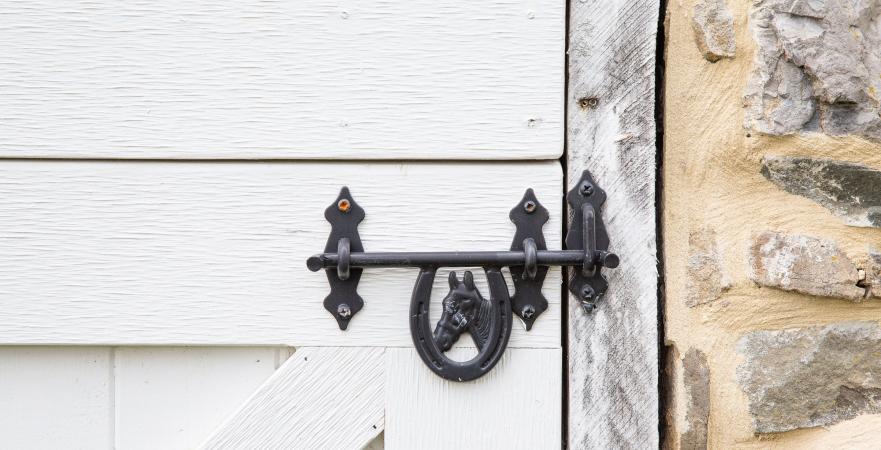According to the date chiseled in the foundation stone, the McDowells built the barn in 1796. It is built in a typical Pennsylvania style, with the most prominent feature being the forebay. Pennsylvania-style barns usually have a central threshing floor, 2 mow bays, a granary, a gable roof, and a lower level for horses, cows, and other animals. This barn was no exception, having a granary with 8 compartments. Some of these markings can still be seen today in the original German. The lower level had four sections for animals, including horses, small goats and sheep, and an end section for cattle.
Preservation of a Dream
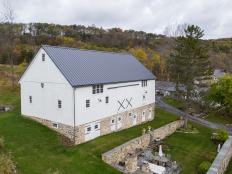
A barn is built
The Kennedy farm began in 1748 when John McDowell brought his family from Ireland and settled in the area. His daughter, Jane McDowell, married Lieutenant Elijah Shoemaker, who later died in the Wyoming Massacre of 1778 along with 300 other settlers. Shortly thereafter, a man, John Shaw, came by the farm to gather supplies for the survivors. A bright spot emerged from this tragedy when he met Hannah McDowell, another daughter, whilst asking for flour and food for the animals. They ended up marrying, and the current barn* on the property played a part in their wedding—hiding fugitives fleeing from the Wyoming Valley after the massacre! Eventually, they turned over the farm to their son, Peter Shaw.
Hard times came to the Shaw farm in the early 19th century. The farmhouse was burnt in an Indian raid. Peter Shaw built a second farmhouse which still stands today.
The farm stayed in the McDowell family until the 20th century, although they carved off part of their property for the Cherry Valley United Methodist Church, which is home to one of the oldest cemeteries in the area. The next owner was Floyd Gibbons, one of radio’s first news reporters/commentators. He owned it until his death in 1939. Raymond Munson bought the property from Gibbons, and in the early 1960s, the property was sold to the Christine family. It was while they owned it that the Kennedy family first saw it. Finally, in 2013, they purchased the property—becoming the 6th owner since the McDowell family first settled it in 1748.
The Kennedys buy the property
The Kennedy family’s interest in the property near Cherry Valley began years before they purchased it. Rob Kennedy’s father had started a basketball camp in the 1960s at an adjoining farm, and he grew up spending summers at this camp. While at camp, Rob would often run up the hill to see the barn. When Rob moved to the area in the 1990s, the barn had fallen into disrepair. After they were married, Rob and Gina would drive by the house and comment on how they would love to live there. Gina even told the owner’s son, “If you ever sell the house, call me.”
“My parents will never sell that house,” he said. He was right; they owned it until they died.
Meanwhile, the Kennedys continued their life in a seashore town. Rob Kennedy had grown up in a couple of historic homes. The Kennedys moved to Spring Lake, NJ, and bought an even older home there. Preserving old buildings became an interest for both Rob and Gina. They joined a nonprofit group that discouraged people from knocking down historic homes, serving as consultants when people would reach out for advice about preservation.
When Hurricane Sandy hit, the Kennedys were forced to evacuate, and ended up moving to the Cherry Valley area. One day while out hiking, they came across the old house, now with a sign saying, “For Sale by Owner.” By then, the barn was falling down. The main house was intact, but the roof was leaking. They decided to make an offer, and after working out the details, the property was theirs! Then began the house restoration, but the barn looked overwhelming. In Rob’s own words, “I thought, ‘Wow, what did we get ourselves into?’”
Could the barn still be restored? Eight to ten contractors came, looked at the large span and condition of the barn and said, “Good luck,” walking out without giving an estimate. So Gina began studying about the history of Pennsylvania barns. She visited 11 barns, and two barn historians she met taught them a lot about the barn’s history. Rob and Gina learned from them how it could be preserved. It looked like one of the largest, northernmost barns built in the Pennsylvania style. An architect came and drew up some plans, but they still didn’t begin repairs. Meanwhile, they stabilized the barn to keep it from collapsing before it could be restored. Surrounding trees were uprooted so the foundation remained solid.
Two years after beginning the search, the Kennedys found Stable Hollow Construction, whose vision, and practical, pragmatic approach to barn restoration impressed them. They planned to restore the barn in place, instead of the more radical approach of dismantling the whole barn. Between the practical approach, clear expertise in barn work, and craftsmanship on other properties they had done, the Kennedys trusted them with this difficult project.
The barn would remain an essential piece of the property’s history. Even though the most common thing to do would be to knock it down, the Kennedys didn’t care if the floor was a little uneven. Often, restoring historic structures comes with a lot of negativity, and it was important to the Kennedys to find someone with the willingness and vision that it could be done.
Restoration begins
When Stable Hollow first arrived, the situation seemed like a complete disaster, with the barn on the verge of collapse and dangerous holes in the floor. The lower level was covered in 3 feet of manure. A silo on the northwest corner had collapsed, allowing water to come in and deteriorate the corner of the foundation. The lean-to’s foundation was also deteriorating, causing the whole wall of the forebay to crumble and collapse. So, first of all, Stable Hollow removed the heavy slate roof weighing down the barn and the crumbling, collapsing lean-to.
Stable Hollow shored up the structure inside, suspending the northwest corner to rebuild the foundation underneath. They temporarily removed the corn crib with a crane and tied the main beams together so the barn wouldn’t flatten out. One winter, all that was holding the barn together and keeping the roof from collapsing was what can best be described as a “spider contraption” that the Kennedys and Stable Hollow had created together.
The floor joists had been spliced, and some framing needed to be reworked. Stable Hollow painstakingly protected as much of the original barn wood as possible, repurposing as much as they could. Some of the wood even predates the barn, from early to mid-1700s.
When restoring the gables, both ends were able to keep the original wood. The gable closest to the house has clapboard. The gable on the other end was missing pieces, and the south main side of the barn had no wood. But on the other side, they saved any old wood and used it for the other gable. The main sides were replaced with new barn wood.
The owners had grown accustomed to the bright, airy view of the mountains and the Appalachian trail provided from the missing barn side, so they had the idea of installing big rolling doors where the hole once was, providing more airflow and magnificent views. A wood railing stretches across to keep it safe.
The new handmade, wooden windows fit right in. Leftover wood was used for kitchen shelving. Piles of slate still remain from the roof replaced with standing seam metal.
The Kennedy barn has multiple interesting features. One is a curved ladder, unique to the barn, that went from the upper levels for the granary and hay storage. This original ladder did not rot and is still in the barn today.
The barn’s future
Now, the view of the barn makes the property. Stable Hollow built and restored the fireplace, and built in a pizza oven and grill, which the Kennedys now use for parties and entertaining.
“There’s something aesthetically beautiful that makes the barn itself part of the view. The stonework, the crispness of the white clapboard. When driving up the lane, and the barn lights are on, it gives off a very peaceful and relaxing vibe. Something that can decompress you. In the summer, we grill and are out with family and friends, start a fire, and sit out there for hours, just talking,” say Rob and Gina now.
The Kennedy’s vision moving forward is to fix up the meadow and lower level of the barn for animals. All the original railings and gates were saved, and Stable Hollow fixed up the lower level with the intention of putting the stalls back in. The Kennedys would love to turn their small farm into a hobby farm, maybe even introduce a sanctuary, a place for rescued animals to live. Restoring the barn began a whole new chapter in their lives.
*this may have been an older barn as the current barn’s date stone says 1796.
Customer review
Thank goodness we found Stable Hollow to preserve it. Now it’s hard to imagine what the property would be like if that barn wasn’t there.
Rob and Gina
